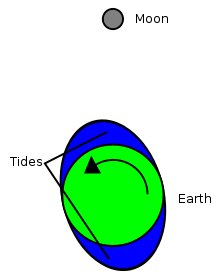Courtesy of our moon, you get an extra long Saturday this weekend: one second longer. It’s because of the earth-moon interaction, the moon tugs on the earth’s tidal bulge, earth returns the favor by accelerating the moon slightly and pushing it further away. So every now and then we have to add in an extra second to keep up with it all. That day is today:
NASA— From VLBI, scientists have learned that Earth is not the most reliable timekeeper. The planet’s rotation is slowing down overall because of tidal forces between Earth and the moon. Roughly every 100 years, the day gets about 1.4 milliseconds, or 1.4 thousandths of a second, longer. Granted, that’s about 100 or 200 times faster than the blink of an eye. But if you add up that small discrepancy every day for years and years, it can make a very big difference indeed.
“At the time of the dinosaurs, Earth completed one rotation in about 23 hours,” says MacMillan, who is a member of the VLBI team at NASA Goddard. “In the year 1820, a rotation took exactly 24 hours, or 86,400 standard seconds. Since 1820, the mean solar day has increased by about 2.5 milliseconds.”
Today will last the normal time of 23 hours 56 minutes and 4 seconds, plus one because of the leap second. Thanks to physics and fossils, we know with some precision the day was much shorter in the deep past. Half a billion years ago, at the end of the Cambrian, it lasted about 21 hours. A billion years ago, during the snowball earth days of Cryogenian, the day lasted only about 17 to 18 hours. Several billion years ago, the first simple cells lived and died under an enormous moon, much closer than it is today, and the day lasted about 10 to 14 hours.
If we had no moon, the earth would not have slowed down much at all. It would still be spinning so fast the day would only last roughly eight hours or less. Each year would have about a 1000 short days. Then again, if we had no large moon that formed so close overhead, you wouldn’t be reading this, because none of us would be here!


Did anyone tell Bill O’Reilly about this? I thought not, didn’t hear him swear and rant.
The conclusions above, by the way, are not simply based on theoretical calculations. Some shelled organism grow daily as well as yearly growth lines or rings, and counting of them shows that there were about 400 rings (days) per year 400 million years ago.
No particular significance to the correspondence of numbers (400) by the way, it’s just that I remember that particular number because of it.